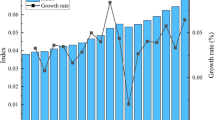Abstract
Urbanization and industrialization have become the major drivers behind economic growth in China and the ASEAN region. The traditional extensive development pattern in the past can no longer sustain. Resource and environment constraints require China and ASEAN to leverage on the reform at supply and demand sides to promote green development. With very good ecological foundation and increasingly higher attention to environment protection, China and ASEAN have shaped fairly full-fledged ecological and environmental governance system. This chapter analyzes the environment-development relationship in China, Singapore, Vietnam, and Myanmar with the consideration of their economic development level and representativeness. It also analyzes the two major contradictions in green development: that between fast increasing economic aggregate and total emission as well as relationship of economic development and urban environmental capacity and quality during fast urbanization. The two sets of relations can affect green development. In addition, industrial transfer in China and the ASEAN region as well as such policy initiatives as Belt and Road Initiative also provided cooperation and development opportunities for regional green development.
Access this chapter
Tax calculation will be finalised at checkout
Purchases are for personal use only
Similar content being viewed by others
Notes
- 1.
Biodiversity, the material basis for the survival of mankind, has direct value and indirect value. The direct value includes food, medicines, and industrial raw materials that human obtains from wild and domesticated components of biodiversity, as well as recreation and tourism value. The indirect value is mainly associated with the functions of ecosystems, covering hydrological process regulation, soil erosion prevention, climate regulation, pollutant absorption and decomposition, nutrient storage and recycling. In the long run, the maximum value of biodiversity is to provide human with the living conditions for adaptation to local and global changes. Green development emphasizes sustainability of social and economic operation and fundamentally protects biodiversity and ensures normal ecosystem services by minimizing damage to the ecological environment in development process.
References
Zhou, G., et. al.: Regional Environmental Protection International Cooperation Strategy and Policy—Observation and Research on Asia-Pacific Environment. China Environment Press, Beijing (2014)
UNDP: Human Development Report 2014—Sustaining Human Progress: Reducing Vulnerabilities and Building Resilience. http://hdr.undp.org/en/content/human-development-report-2014 (2014)
Peng, B., Liu, X., Yang, Z.: Status of Resources and Environment and Potential of Cooperation in ASEAN. Social Sciences Academic Press, Beijing (2013)
Author information
Authors and Affiliations
Consortia
Rights and permissions
Copyright information
© 2018 China Environment Publishing Group Co., Ltd. and Springer Nature Singapore Pte Ltd.
About this chapter
Cite this chapter
China-ASEAN Environmental Cooperation Center. (2018). Drivers, Features, and Opportunities for Regional Green Development. In: China-ASEAN Environment Outlook 1 (CAEO-1). Springer, Singapore. https://doi.org/10.1007/978-981-10-6211-7_3
Download citation
DOI: https://doi.org/10.1007/978-981-10-6211-7_3
Published:
Publisher Name: Springer, Singapore
Print ISBN: 978-981-10-6210-0
Online ISBN: 978-981-10-6211-7
eBook Packages: Earth and Environmental ScienceEarth and Environmental Science (R0)




